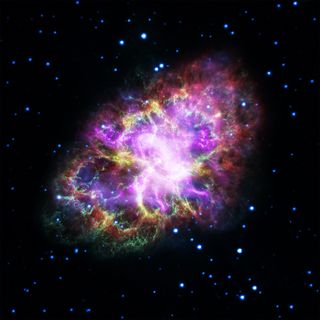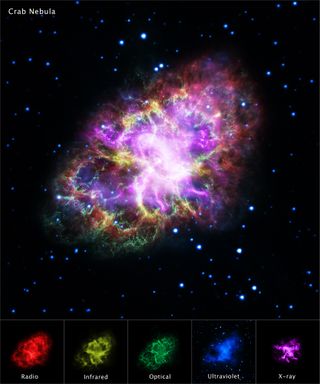Telescope All-Star Team Feasts on Crab Nebula with Spectacular Results

Telescopes around the world have teamed up to crack open the Crab Nebula, the dusty remnants of an exploded star. By combining different types of observations, astronomers produced one of the most detailed images of the stunning space cloud to date.
The Crab Nebula (M1) lies 6,500 light-years away from Earth in the constellation Taurus and is barely visible to the naked eye. It measures about 10 light-years across and is constantly expanding.
At the core of this giant cloud of gas and dust is a rapidly spinning neutron star, or the tiny, dense corpse of a star that exploded about a millennium ago. Known as a pulsar, this type of neutron star appears to flicker periodically as it rotates. The pulsar at the heart of the Crab Nebula flickers about once every 33 milliseconds. [Photos: Amazing Views of the Famous Crab Nebula]
To get a thorough look at what's going on inside this giant space cloud, astronomers combined data from five different telescopes that observed the nebula in different wavelengths, or types of light.
The Karl G. Jansky Very Large Array looked at the radio waves coming from the nebula (shown in red), while the Spitzer Space Telescope looked at the infrared light (yellow), the Hubble Space Telescope studied the visible light (green), the XMM-Newton space telescope measured the ultraviolet radiation (blue) and the Chandra X-ray Observatory looked at the X-rays (purple).

"Comparing these new images, made at different wavelengths, is providing us with a wealth of new detail about the Crab Nebula," Gloria Dubner, a researcher at the University of Buenos Aires who led the project, said in a statement. "Though the Crab has been studied extensively for years, we still have much to learn about it."
Dubner and her colleagues detailed their new observations of the Crab Nebula in a paper published in The Astrophysical Journal on Wednesday (May 10).
Get the Space.com Newsletter
Breaking space news, the latest updates on rocket launches, skywatching events and more!
Email Hanneke Weitering at hweitering@space.com or follow her @hannekescience. Follow us @Spacedotcom, Facebook and Google+. Original article on Space.com.
Join our Space Forums to keep talking space on the latest missions, night sky and more! And if you have a news tip, correction or comment, let us know at: community@space.com.

Hanneke Weitering is a multimedia journalist in the Pacific Northwest reporting on the future of aviation at FutureFlight.aero and Aviation International News and was previously the Editor for Spaceflight and Astronomy news here at Space.com. As an editor with over 10 years of experience in science journalism she has previously written for Scholastic Classroom Magazines, MedPage Today and The Joint Institute for Computational Sciences at Oak Ridge National Laboratory. After studying physics at the University of Tennessee in her hometown of Knoxville, she earned her graduate degree in Science, Health and Environmental Reporting (SHERP) from New York University. Hanneke joined the Space.com team in 2016 as a staff writer and producer, covering topics including spaceflight and astronomy. She currently lives in Seattle, home of the Space Needle, with her cat and two snakes. In her spare time, Hanneke enjoys exploring the Rocky Mountains, basking in nature and looking for dark skies to gaze at the cosmos.
